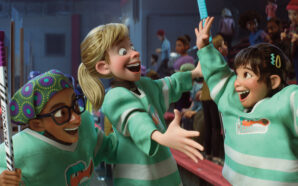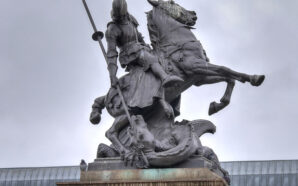Arturo Hilario
El Observador
Walt Disney Animation Studios’ “Raya and the Last Dragon” focuses on a mystical and fantastic new world inspired by Southeast Asian cultures and locations.
In the film, Kumandra is a place where humans and dragons live amongst each other until an evil entity forces the dragons to sacrifice themselves to save humanity.
500 years after those events the evil returns and it is up to a young warrior, Raya (voiced by Kelly Marie Tran), to find one of the legendary dragons to help her in saving the world. The dragon she ends up finding is Sisu (Awkwafina), a sort of runt of the litter of the ancient dragon siblings. Together, alongside a slew of other characters they befriend and enlist to help on the way, Raya and her friends must learn to trust and use not only the powers of the mystical dragon Sisu, but also the teamwork of her new friends to stop the evil ravaging Kumandra.
Recently I had the opportunity to speak to some of the creative team behind “Raya and the Last Dragon”, directors Don Hall and Carlos López Estrada, as well as writer Qui Nguyen. We went over what each of them brought along to the creation of the film, as well as their experiences bringing “Raya and the Last Dragon” to life.
Director’s Don Hall and Carlos López Estrada previously worked on Oscar winning “Big Hero 6” and the critically acclaimed independent film “Blindspotting”, respectively. Writer Qui Nguyen is a playwright with over ten plays on his resume, and writing credits with Netflix, and the AMC and Syfy networks.
To start off, I wanted to ask Qui about the writing. Could you explain where the genesis of this story came from and how you worked on developing it?
Qui Nguyen
Well, with Disney films it usually goes through a long genesis process. And like the beginning of this movie started almost six years ago as an inkling of an idea and [had] been floating around the studio. Then we got to be part of this as a story trust, just kind of giving our notes when it comes to different iterations of the movie that we got to see. But when it came to us coming in, Don, Carlos, and myself all came on to the movie a year and a half ago.
So, we kind of came in after baby had started walking already. And we were like, “Oh, baby, probably needs some pants and a shirt and shoes.” So that’s what we started working on and making sure baby doesn’t die. So, I don’t know why I went with that analogy. But, you know, honestly, it was a movie I was very excited to write and be able to tell a story of a character that I had never gotten to see on such a large scale, especially at the level of a Walt Disney movie.
And so, it was a chance to be able to see a Southeast Asian superhero, basically. And Princess. I was very, very excited about that. But yeah, you’re welcome with the baby analogy.
So, Don, how long were you involved with the project and where did you start off?
Don Hall
It was the same. So, we all three came on for about a year and a half ago in Qui and I were and are now working on a different project. And Carlos, who had started, you know, about a year prior, I think was also on another project. So, we all came together at around the same time to work on Raya. And like we alluded to, we’d seen multiple iterations over the years, collaborated on multiple iterations because that’s just how, you know, that’s what our that’s what we do in this trust, we hop on and help out whenever asked. And that’s kind of what led to us three coming on.
Can you give me an idea about what the process of collaboration is with the writing and directing departments?
Carlos López Estrada
It’s very, very close. Essentially, I think what’s different from the animation the Disney animation process, is that you don’t get a script from a writer and then you go, and you produce it. This is really like Qui and us met every day for like seven months working on this movie, probably even longer than that.
Just because the movie kept evolving. We kept discovering things, when the actors came on, it kept growing and the script really never was locked until the time the last scene was animated. So, we were starting to animate some scenes and we were still writing some other sections. We would screen some parts of the movie and get feedback and then Qui would still go in and rework them. So that’s what’s different about this, Qui is a key creator in the animation process, and he was really taking feedback and applying it up until probably a few months ago.
Don
And so, it is hard to under sell the extent with which we collaborate. And I know it’s a little different than live action. You know how typical live action films are built from a story perspective? I think it’s different than even like Miyazaki, how he develops his films. You know, Miyazaki is an auteur. He dreams it up, he draws it up, and then directs everybody to achieve that vision. And so, for us, it’s almost the polar opposite. It’s this wild collaboration between so many people that it can get chaotic at times. And our job as directors really is to A) you know, obviously have a vision for the film and be able to communicate it clearly, but also B) sift through hundreds and thousands of, you know, collaborative, creative input choices, you know, and it’s almost an embarrassment of riches. And sometimes, you know, that’s the hardest part of our job sometimes – just knowing what to use and what to say no to, you know, and what to try and what not to try. But that’s just been part of our process for years.
Now, Carlos, I spoke to you when you were doing “Blindspotting” a couple years ago, so I was really curious to know what it was like coming from a film like a live action film and before that music videos into a feature like animation?
Carlos
I think, you know, there are so many similarities. It’s really all visual storytelling and it’s really just constructing this story. So, on the surface, it would seem like they’re completely different mediums. But we found out, Qui, Don and I, that we really spoke the same language. And obviously the tools and the size and the scope of this production are unlike anything I’ve ever done. But the concepts of directing, the concepts of acting and design, they really all translate really, really well. I think for me it was the learning curve was really just getting to understand how the pipeline of the studio and the very particular process that they follow in developing their movies, storyboarding their movies, moving onto animation.
And Don, I think was really kind of ally in that for both me and Qui, because it was our first animated movie that went into production. So, I think that we both really leaned on him and just said, “Hey, Don, we can provide our sensibility, we can provide our feedback and I think where we can really help with this movie but we’re going to need your help as well, just in understanding this universe that is new to us.” [Don] and the rest of our crew and the studio is so warm and so welcoming in having us in and knowing that, you know, our opinion and our point of view is very important, but also, we have to learn from them. And there’s so many talented people in that building.
And lastly, I was wondering, even though it’s a fantasy world setting, how important was it to be respectful of Asian culture in this film and how you approached it?
Don
Oh, it was it was paramount. I mean, it was so absolutely, absolutely essential and not in a kind of homework-y kind of way, or an academic way. It was through inspiration and a desire to getting inspired by the different cultures to even make the film, you know, that’s going to profile those cultures.
But you know, it was in every decision that we made, was in collaboration with the Southeast Asian Story Trust from the crest on Sisu’s head to, the designs that are on Raya’s cape. So big decisions, small decisions. And even in the different iterations of the story, the script and the story reels were embedded in deep consultation with our Southeast Asian Story Trust.
So, and again, wasn’t out of any kind of academic checklist. It was it was being inspired by the different cultures of Southeast Asia and wanting to do right by them, you know, make sure that they’re there as proud of this movie as we are.






